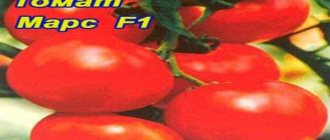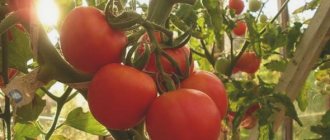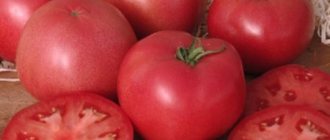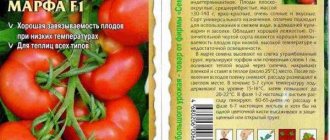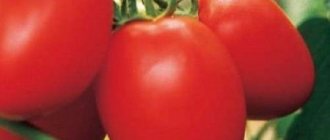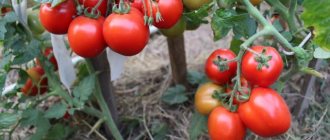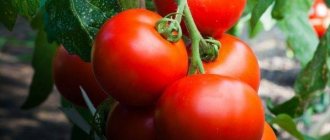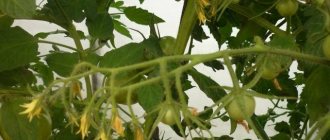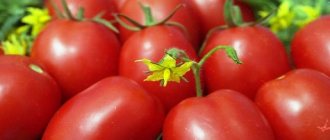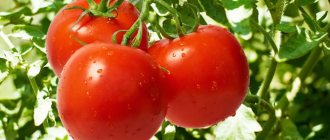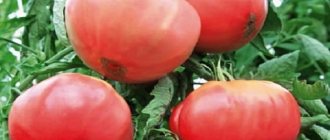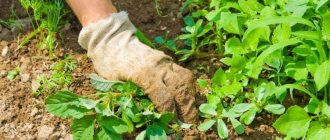Many gardeners try to grow hybrids on their plots, for example, the Vologda tomato. They differ from conventional varieties in their high yield and greater resistance to many diseases. They are obtained as a result of artificial crossing of two varieties.
Typically, packages of hybrid seeds are marked with the F1 symbol. The only thing that is impractical for them is to collect seeds and sow them the next year, since all the maternal qualities of the plant will be lost.
You will have to purchase new seeds every year from specialized stores. Among the hybrids, the tomato variety Vologda F1 enjoys attention.
Description of the variety and features of growing tomato Supergiant pink f1
The favorite of gardeners, the Supergiant Pink F1 tomato from the Russian Ogorod company firmly holds the leading position in the sale of seeds for summer residents. The sum of the positive qualities of fruits and plants makes us turn to this hybrid again and again.
Agronomic characteristics
The plant is determinate, its height does not exceed 70 cm, and does not require pinching or staking. Great for vegetable gardens and greenhouses. The first harvest can be made in mid-July - early August, at least 110 days must pass from germination. Ripening period is mid-early.
The fruits are dense, smooth, pink in color, large, average weight from 250 to 350 g, with good care increases to 400 g. The taste is dessert; when cut, the fruit is fleshy with a small number of seeds. Sugar content is high. The transportability of the harvest of these tomatoes is very good, since they are dense and hard and can be stored for a long time. The skin is edible and tender. Disease resistance is high.
Features of cultivation
Tomatoes Supergiant pink F1 prefer fertile soils, moderately moist, with a lumpy structure. The highest fruiting is achieved at an air temperature of 24-26 o C
Among the features of cultivation, it is important to remember:
- Sowing of seedlings should be done in early March. Plants should not be overgrown. The best seedlings have 6-7 true leaves. If the seedlings are a little smaller, then they take root better compared to larger plants;
- When blossom end rot appears, plants need to be fertilized with sodium nitrate;
- Watering should be carried out during the phase of budding, fruit set and the beginning of ripening.
Tomatoes Supergiant pink F1 are often confused with hybrids of similar names:
tomato Supergiant XXL PP F1 is an indeterminate hybrid up to 2 m high with giant fruits weighing up to 2 kg
It is important to understand that determinants cannot bear fruit of this weight. On the contrary, if there are a large number of ovaries, they tend to reduce the weight of tomatoes; supergiant tomato Russian size F1 - also indeterminate, up to 2 m high, intended for greenhouses of all types, and is almost never grown in open ground
This hybrid is a late-ripening hybrid and ripens in 125-128 days from seed germination, the weight of its fruits is very large - from 600 to 2000 g, it is slightly ribbed, red, and juicy. Requires gartering and pinching.
Measures to increase yield
The best incentive for fruiting of the Supergiant pink F1 tomato, retaining the fruits on the bush and increasing their taste in the garden is organic feeding:
- 20-24 days after planting in the garden, the tomatoes are fed. The fertilizer solution must be infused, so it is prepared in advance. Fresh mullein in a volume of 2 liters is diluted in 10 liters of water and left for 5-7 days. To feed, the resulting solution is diluted with water 1:5 and the tomatoes are watered at the rate of 0.5 l/plant;
- The second feeding is needed at the beginning of fruiting, take 0.2 liters of fresh chicken manure per 10 liters of water, water it at the root at the rate of 1 liter/plant, it is not necessary to infuse the manure solution;
- If the plants drop flowers or their leaves are curled, then fertilizing with borax is necessary at the rate of 5 g per 10 liters of water; the plants should be sprayed and watered under each root with at least 1 liter.
Tomatoes of the Supergiant pink F1 variety are gaining more and more positive reviews from gardeners and gardeners every year. The majority of consumers are delighted with the taste of these tomatoes, their high yield, and the long shelf life of the fruit.
The hybrid is suitable for growing in seedless culture. To do this, the seeds are sown in a bed under a film in early April. When the first true leaf grows, the crops are thinned out and the film is removed. The fruits are obtained in September. If you harvest them before frost in the stage of milky-wax ripeness, you can get fresh tomatoes for a long time by ripening them indoors.
Text version
Where is this hybrid, we call it their hit of the season, it is very popular among amateurs and professionals, it is an indeterminate type plant, relatively: The trains are ripe, it is approximately 110 to 115 days of germination before fruiting, it is grown in winter greenhouses, but amateurs and farmers grow it. In their greenhouses, whoever has these plants begins to form honors.
The best varieties of tomatoes
With 9 11 leaves and everything usually happens you have from 3 to 5 fruits weighing from 450 to 600 700 grams are the fruits very dense?
Large ones that are stored for a long time means when does it start?
Harvest tomatoes
As they ripen, they go through several stages: first they become yellow, then pink, then they acquire. Such a light red and then dark red color and an amazing thing, these fruits can be stored for two months without problems, or even longer depending on the temperature.
If they keep it in normal room conditions, then about 16-18 degrees, then they save themselves from problems for two months if the temperature is maintained.
Video: Tomato hybrids: super bomb from Ilyinichna!
Video: The most honest review of tomatoes: the best tomatoes 2021. The most productive varieties and hybrids of tomatoes!
Ilyinichna
13 18 degrees can be preserved and lasts longer, in addition to dense paint, it is determined by the fact that they have a thick wall:
Usually there are five or six chambers, these chambers are well made, that is, the fruits have high taste qualities, and what does this taste have to do with it?
Firm Ilyinichna
The qualities begin to be acquired from the moment they are harvested in the winter greenhouses we grew. These hybrids were given to Vologda for which it is called Vologda grad because of the conditions:
At the Vologda greenhouse plant, it gave a yield of 54-56 kilograms per square meter, which is a very good harvest. For the family, the condition of Vologda is because the wolf is already in the first zones with low light levels and short days in winter.
Agrofirm Ilyinichna
The period and of course these moments are so significant. Not very long ago, one of our graduate students grew this hybrid here in the Moscow region under film frames. And I was extremely surprised that from the film frames this hybrid gave him a magnificent harvest of excellent quality and a very beautiful shape.
Such a round or flat round ordinary muslin is formed by 5 7 flowers; if you want to get larger fruits, then you need to leave 34 then: The mass of the fruit will be about 450 grams; if you leave all five or six flowers, then of course the mass of the fruit. It will be about 300-350 grams, the smaller the number of flowers you leave:
Video: Introduction to the Ilyinichna company: the best tomatoes and gifts
Video: Super-yielding tomato Scarlet Frigate from the Poisk agricultural company. Early ripening indeterminate tomato for greenhouses.
Tomatoes 2019
He said the blood will be larger until the fetus is larger, that is, the weight of the fetus will also be about the same. There are one and a half two kilograms, but the size of the fruit depends:
From the number of flowers from the number of fruits that are formed at this session. This is such a small nuance, let’s say the fruits have a very uniform beautiful light green color without a spot on the stalk, as is often the case.
Cold tolerant tomato
It is very easy to tear off; if you start storing these fruits, then gray days of rot come from the stalk; the fruits rot, but here they come off easily.
The spots on the stalk remain dry due to this.
Cold resistant then
The preservation of fruits is much higher.
A delicious decoration for the greenhouse - the Yellow Date tomato: description of the tomato variety, care features
Gardeners who have a greenhouse on their property should pay attention to the sweetest varieties of tomatoes intended for growing indoors. A tall variety that requires the formation of a bush with 2 stems and the removal of numerous stepsons
Tomatoes take about 4 months to ripen. The fruits are shaped like barrels with glossy yellow skin. The weight of an average tomato is 200 g. It received its name for its similarity to honey in color and taste of the pulp.
A tall variety that requires the formation of a bush of 2 stems and the removal of numerous stepsons. Tomatoes take about 4 months to ripen. The fruits are shaped like barrels with glossy yellow skin. The weight of an average tomato is 200 g. It received its name for its similarity to honey in color and taste of the pulp.
Valued for the original color and sweetness of the fruit. Large, round, yellow fruits have bright red spots over the entire surface of the peel. It takes at least 4 months from sowing seeds to harvesting. The plant needs constant formation of a tall bush and support. Productivity 6-7 kg/m2.
Mid-season tomato variety for indoor soil. A characteristic feature is highly branched racemes strewn with fruits. Up to 50 cream-shaped tomatoes ripen on one branch at the same time. The taste is rich, sweet, the flesh is pink with a pleasant fruity aroma.
Small-fruited, productive varieties are especially popular today. They are grown in gardens and greenhouses; children love the small, beautiful fruits.
Among the popular sweet varieties of tomatoes, there are varieties that are successfully cultivated both in open beds and in protected ground. As a rule, the same variety produces more yield in a greenhouse. At the same time, the bushes stretch more strongly in closed ground. Therefore, height, yield and agricultural practices may vary slightly.
An early-ripening, large-fruited variety of determinate type. In open ground it grows up to 70 cm, in a greenhouse it reaches 1.2 meters. Valued by gardeners for its yield (6 kg per bush) and very tasty fruits. Ripe, sweet tomatoes weigh 250-400 g and have a round, flattened shape.
Tall tomato with medium ripening period. The fruits are elongated, collected in clusters of 5-6 pieces. Gardeners note a pronounced sweet taste when grown both in a greenhouse and in open beds. The average weight of a tomato is 300 g. The pulp and skin of tomatoes has a rich yellow color.
Sugar variety of tomatoes up to 1.2 meters high in a greenhouse. Harvest occurs at the end of summer. The bushes form numerous fruit clusters with miniature red “cherries”. It is valued by gardeners for its high yield and excellent taste of fruits, which children really like.
Large-fruited variety with attractive dark-colored fruits. Grows up to 1.5 m, needs staking. When ripe, the rounded fruits take on a milk chocolate hue. The pulp is incredibly sweet and juicy. Refers to mid-early varieties of universal use.
Famous for its taste. The fruits are large (300-600 g), pink, fleshy. Ripens within 100-110 days. A bush 1.5 meters high needs support and removal of stepsons. To increase productivity, form into 2 stems. Resistant to temperature changes.
It happens that after planting a sweet variety on a plot, gardeners are disappointed in the taste of the harvested vegetables. Tomatoes grow watery and bland. The high sugar content in vegetable fruits depends not only on varietal characteristics. In order to enjoy honey tomatoes grown in your garden, you need to provide them with enough sunlight. Therefore, the most illuminated areas of the garden are chosen for tomato beds.
The taste of ripe tomatoes is influenced by additional fertilizing and proper agricultural technology. If you water the bushes frequently, but with a small amount of water, the pulp will become watery and lose its sweetness and aroma. Proper watering involves a large amount of liquid at intervals of 2-3 days, so that the soil around the bush dries out a little.
It should also be taken into account that the sugar content is fully revealed only if the fruit is ripe on the branch
Therefore, it is important to select varieties that will have time to reach ripeness before the development of late blight and cold snap. Experienced gardeners plant basil between tomato rows
Joint cultivation has a beneficial effect on the taste of both crops.
Growing high-yielding sweet tomatoes in your garden is not difficult. The right variety, adherence to basic agricultural practices and a little hard work can achieve impressive results.
Advantages of the variety
The advantage of this tomato hybrid is its resistance to many diseases. Tobacco mosaic, fusarium, and cladosporiosis are not dangerous to it. Unfortunately, like all other tomatoes, it can suffer from late blight. The hybrid is characterized by high productivity. With good care, up to 5 kg of tomatoes ripen on one plant.
To obtain high yields, suitable climatic and weather conditions are important. Reviews of Vologda F1 tomatoes are mostly positive. With proper care, most gardeners get high yields and are satisfied with this variety.
Vologda F1 tomatoes are also convenient because they are easy to transport. The fruits have the most convenient size for canning, so we recommend growing them on site.
All varieties and hybrids are resistant to at least 3-4 tomato diseases. Among the new products there are resistant to 5-6 diseases. “Ilyinichna” offers hybrids resistant to brown spot, fusarium wilt, tobacco mosaic virus, root-knot nematode, and powdery mildew. With high yield and quality of fruits.
Tomatoes are poorly susceptible to weather stress. They produce strong pollen, resulting in well-set tomatoes without stimulants, even if the weather is unfavorable. The F1 hybrid Olya is not afraid of low temperatures (+7-13°C), and the F1 hybrids Ramsay, Ramses, Vologda grad, Waltz can withstand heat of more than +50°C.
Tomato F1 Red Arrow
An exceptionally reliable hybrid. Excellent taste and yield, besides, late blight gets to it last. The hybrid is determinate, early ripening (95-110 days from germination to harvest), tolerates low light and stress.
The plants are low-growing, weakly leafy, and do not require pinching. With a height of 120 cm, the plant has 10-12 brushes located every 0.8-1 leaves. The fruits are round, smooth, dense, intensely red, fleshy.
Resistant to tobacco mosaic virus, cladosporiosis, fusarium, tolerant to bacterial wilting diseases and root-knot nematodes. Used fresh and for canning, it is perfectly preserved during transportation.
Tomato F1 Titanic
Popular due to its beautiful shape, large fruit (400 g), and taste. The hybrid is mid-early: 113 days pass from germination to fruit ripening. The plants are indeterminate, vigorous, weakly branched, well-leafed, and form into a single stem (the few shoots must be promptly removed).
The hybrid is characterized by abundant fruiting. The cluster is simple, with 5-6 fruits weighing more than 200 g. The skin of the fruits is thin, so it is better to collect them without the stalk and transport them in a container intended for large fruits, in one row.
The hybrid is resistant to tobacco mosaic virus, cladosporiosis, fusarium, and root-knot nematodes. Productivity – 22-40 kg per square meter. m and 7-13 kg per sq. m in summer-autumn rotation, up to 18 kg per sq. m – in film greenhouses.
Tomato F1 Vologda-grad
Its large (290-350 g) and dense orange-red fruits, even when picked ripe, last for about 40 days at room temperature and do not spoil. Mid-season, high-yielding indeterminate hybrid with excellent fruit formation and weak shoot-forming ability. The clusters are compact, with 4-5 large fruits. They are collected when the red color appears.
Description of the fruits of the hybrid Vologda
On tall bushes a large number of round and red tomatoes are formed. They are of medium size and their weight does not exceed 120 g. The tomato skin is thick enough to prevent the tomatoes from cracking during canning. In addition, they can be stored for a long time and transported over long distances without the risk of losing their presentation. The fruits adhere perfectly to the bushes and do not fall, which guarantees the safety of the harvest.
If necessary, you can harvest tomatoes a little earlier than they are fully ripe, since they can easily reach full maturity outside the bush. Most often, the need for early harvesting arises when there is a threat of late blight.
The Vologda variety is considered resistant to most diseases, but late blight is not excluded. Eliminating the disease may be difficult, but saving the crop is quite possible. There is no need to worry that the tomatoes will spoil, as they reach full ripeness well on the windowsill.
Many gardeners try to grow hybrids on their plots, for example, the Vologda tomato. They differ from conventional varieties in their high yield and greater resistance to many diseases. They are obtained as a result of artificial crossing of two varieties.
You will have to purchase new seeds every year from specialized stores.
Among the hybrids, the tomato variety Vologda F1 enjoys attention
Hybrid Vologda motifs
Tomatoes intended for cultivation in open ground have become widespread. They compare favorably with other varieties because they have unlimited growth. Planting is done in the ground in June, and seeds are planted in the greenhouse in April - May.
The main characteristic of the variety is its unusual leaves that resemble lace. The pulp of the fruit is dense, rich, tasty and aromatic. Plants in open ground are planted immediately after planting.
To prevent late blight disease, the first treatment of tomatoes with systemic preparations is carried out during the period of their intensive growth, without waiting for signs of the disease to appear.
Tomato Vologda motives has a germination rate of 96%. Experienced gardeners pay attention to the plant’s need for moisture, and when growing a determinate variety, they form the bush like a fruit tree.
Seedlings are planted according to the planned pattern: the distance between plants is 30 cm, in rows - 60 cm. The best varieties, with proper care, give a high yield. Plants grow powerful and need to be tied up.
See also
The lazy way to grow tomatoes and the best varieties for this
Read
Tomatoes 2021 - 3
Messages: 4371 Registered: 01/28/2015, 20:13 From: Ryazan region. boot Thanked: 8096 times Thanked: 4457 times
Status: Offline
Posted by tep » 08/20/2017, 10:37
Melon of the North produced decently sized fruits, in general, 2-3 plants of this variety are enough for a family of 4 people, we don’t have time to eat them, and they are not suitable for processing, so next year I will plant smaller ones.
Messages: 6544 Registered: 04/23/2010, 06:00 From: Moscow Thanked: 1289 times Thanked: 1932 times
Status: Offline
Tomatoes 2021 - 2
Posted by Songbird » 08/20/2017, 11:03
Status: Offline
Tomatoes 2021 - 2
Posted by grawicapa » 08/20/2017, 11:36 am
Messages: 12721 Registered: 03/19/2010, 16:39 Interests: Various From: Moscow Northern Administrative Okrug Dacha for Istroi Thanked: 5530 times Thanked: 8798 times
Status: Offline
Tomatoes 2021 - 2
Message from Kuzinamama » 08/20/2017, 11:44
Champion 2009 Messages: 14052 Registered: 03/11/2008, 13:51 From: St. Petersburg Thanked: 7199 times Thanked: 5963 times
Status: Offline
Tomatoes 2021 - 2
Posted by masleno » 08/20/2017, 11:50
Messages: 12721 Registered: 03/19/2010, 16:39 Interests: Various From: Moscow Northern Administrative Okrug Dacha for Istroi Thanked: 5530 times Thanked: 8798 times
Status: Offline
Tomatoes 2021 - 2
Message from Kuzinamama » 08/20/2017, 12:03
Moderator Messages: 14384 Registered: 01.11.2011, 13:20 Occupation: Enjoying life From: Nizhnevartovsk Khanty-Mansi Autonomous Okrug, May 9 Thanked: 5869 times Thanked: 10007 times
Status: Offline
Tomatoes 2021 - 2
Message from Kim » 08/20/2017, 12:04
Catch up, bring joy and do good!
Messages: 6544 Registered: 04/23/2010, 06:00 From: Moscow Thanked: 1289 times Thanked: 1932 times
Status: Offline
Tomatoes 2021 - 2
Posted by Songbird » 08/20/2017, 12:57 pm
Messages: 12721 Registered: 03/19/2010, 16:39 Interests: Various From: Moscow Northern Administrative Okrug Dacha for Istroi Thanked: 5530 times Thanked: 8798 times
Status: Offline
Message from Kuzinamama » 08/20/2017, 14:39
Messages: 173 Registered: 06/10/2015, 12:28 From: Rostov region. Thanked: 126 times Thanked: 145 times
Status: Offline
Posted by KERRY » 08/20/2017, 04:13 pm
Messages: 16040 Registered: 04/30/2009, 19:43 From: Moscow Thanked: 8002 times Thanked: 11634 times
Status: Offline
Message from Anin » 08/20/2017, 16:15
Messages: 6458 Registered: 04/01/2012, 23:25 From: MOSCOW Thanked: 2623 times Thanked: 4050 times
Status: Offline
Message from LENIK » 08/20/2017, 17:08
Twice champion 2009 Messages: 3584 Registered: 12/22/2006, 10:05 AM Interests: from the fence to lunch
https://forum.prihoz.ru/viewtopic.php?p=468037#p468037 Occupation: plumber-san From: Middle East of the Moscow region - Malakhovka Thanked: 1203 times Thanked: 4187 times
Status: Offline
Preparing and planting seeds
When preparing Kostroma tomato seedlings, you should take into account the period when you plan to harvest the fruits. To obtain an early harvest of tomatoes of this variety, it is recommended to sow the seeds at the very beginning of spring, in March. In this case, the seedlings will be prepared for transplanting in April.
It is recommended to treat the prepared soil from a mixture of earth, peat, compost a few days before sowing the seeds with a solution of potassium permanganate, and water it with good water the day before.
Tomato seeds must be calibrated, for which they need to be placed in a solution of potassium permanganate for 15 minutes, and then dried. The prepared seeds must be placed on moist soil at a distance of 4 centimeters from each other, sprinkled with a layer of soil, and the entire area covered with film or a glass structure, ensuring heat retention.
When the first sprouts appear, the film or other covering material must be removed. As soon as the first two leaves are formed, you need to pick: transplantation is carried out in separate cups or in special containers.
40 days after transplantation, the seedlings are considered ready for planting in greenhouse conditions, and the sooner this is done, the sooner you can count on the first fruits.
Breeding Features
Vologda tomatoes are grown in seedlings. The seeds are sown at the end of February. It is advisable to first soak them in water and treat them in a solution of potassium permanganate. Then sow in ready-made moist soil for tomatoes and peppers, purchased at the store. Cover the soil with film and place in a warm place.
In about a week the seeds will sprout. When the first true leaves grow, it is recommended to pick. To do this, it is advisable to choose disposable cups. To extend daylight hours, it is recommended to illuminate the seedlings with a fluorescent lamp. When the plants are 55–60 days old, they must be transplanted into a permanent place in the greenhouse, following a 40x60 cm pattern.
A prerequisite for care is loosening the soil, especially after watering the plants. To increase the yield of tomatoes, it is recommended to loosen and slightly lift the soil up to the first leaves so that an additional root system begins to form.
In the middle zone, tomato seedlings are planted in early May. After some time, the plants need to be tied to a support and fertilized 2 times a month. In the future, they try to form the plant so that there is one stem; when the maximum height is reached, the top is pinched.
See also
Characteristics and description of the Biff Beef tomato variety, its yieldRead
This type of procedure is recommended to be done in August. Until approximately August, abundant watering is carried out; at the beginning of August, irrigation is reduced; towards the end of the month, watering is stopped completely.
Diseases and pests
The Champion tomato variety is very resistant to fungal diseases, but can still suffer from bacterial black spot. In order to get rid of this disease, you need to use the drug “Fitolavin”.
Less commonly, it may be affected by blossom end rot. With this disease, the bushes of the plant are sprayed with a solution of calcium nitrate and the humidity of the environment is reduced. During treatment, you should stop adding nitrogen fertilizers.
The most common pests of this species in the middle zone are white moths, codling moths and sawflies; Lepidocide is used against them. In the southern regions it is often affected by the Colorado potato beetle, they fight it by collecting it with their hands, and then treating it with the drug “Prestige”.
Growing this tomato requires some effort, so it is suitable for experienced gardeners. But the yield will pay off all the efforts; it is very high. Good luck and have a great holiday season.
In the table below you will find links to tomato varieties with different ripening periods:
| Mid-late | Early ripening | Late ripening |
| gold fish | Yamal | Premier |
| Raspberry miracle | Rose of Wind | Grapefruit |
| Miracle of the market | Diva | Bull's heart |
| De Barao Orange | Brawler | Bobcat |
| De Barao Red | Irina | King of Kings |
| Honey fireworks | Pink spam | Grandma's gift |
| Krasnobay F1 | Red Guard | Snowfall F1 |
Description
Tomato hybrids, tomatoes from the Ilyinichna agricultural company, the best tomatoes 2021. Svetlana Ilyinichna Ignatova, breeder, professor, Doctor of Agricultural Sciences, general director of the Ilyinichna breeding and seed company about the best tomato hybrids. Tomato Vologda-Grad F1 is a hybrid that has been a hit of the season for several years. It is classified as the best tomato varieties, the most productive tomato varieties. This is a cold-resistant, cold-resistant tomato, which is also a productive tomato, which is a disease-resistant tomato: late blight resistant, late blight resistant, late blight resistant.
Hybrid varieties
The following types of tomatoes are cultivated in the Northwestern Federal District:
- Godfather
- Watermelon.
- Amazon.
- Black master.
- Cardinal.
- Cardio.
Early ripening varieties ripen 2 weeks earlier than other types of tomatoes.
The most common hybrids are:
Gardeners are especially pleased with the large fruits of the Arizona variety. The bush produces up to 16 kg of high-quality fruits. They have a rich red color, weigh from 100 to 400 g, are dense, and contain a large amount of dry matter and glucose. Tomatoes are used to make juice, ketchup, paste, and consumed fresh. Experienced vegetable growers note the marketable appearance of the fruits and their smooth ripening.
Several bushes of the Cardio variety can provide a family with high-quality fruits. Yablonka, Pharaoh, and Dobrun tomatoes are successfully grown on swampy soils.
Tomatoes do not die from excess moisture and produce a good harvest. Seedlings of some hybrids are grown in beds, covered with glass. In the Vologda region, Krasnobay, Kirzhach, and Belcanto tomato seeds are used to produce seedlings.
Olya, Verlioka, De Barao and Ural tomatoes are tasty and aromatic. In order to get a high yield, it is necessary to choose the right variety: it must correspond to the climatic conditions of the growing area.
Description of the variety Volgogradsky 323
Volgograd early ripening tomato 323 is a low-growing, early ripening variety. From germination to the first ripened fruits, only 102-105 days pass. The bushes are compact, small, up to 45 cm high. The leaves are medium-sized, allowing the plant to be well ventilated. The first brush is formed after 5 sheets, and the subsequent ones - after 1-2 sheets.
Description of fruits
The fruits of the Volgograd early ripening tomato 323 are small, their weight is 60-80 grams, the color is red-orange, the shape is rounded-flat. The taste is good, sweet with a sour aftertaste. The fruits have from 6 to 8 chambers.
Purpose of the variety
The variety is universal. Because of its pleasant taste, it is used fresh, and due to its small size, it is excellent for pickling and preparing a variety of canned food. Various juices, ketchups and tomato pastes are also prepared from the fruits. The rich tomato taste makes the preparations very appetizing.
Disease resistance
Tomatoes Volgograd early ripening 323 are quite resistant to diseases such as verticillium, tobacco mosaic, fusarium and brown spot. Thanks to the work of breeders, the plant is practically not susceptible to these dangerous diseases.
To combat pests, in the fall they dig deep into the soil, burn infected plants, use chemicals, infusions of herbs, hot pepper and garlic.
Plants that repel pests, such as marigolds and calendula, are planted between the rows.
Advantages and disadvantages
The Volgograd early ripening tomato variety has a number of advantages that allow it to have its admirers and supporters among the army of summer residents and gardeners. These include:
- the ability to produce stable, both in greenhouses and in open ground;
- early and friendly yield of fruits;
- compact bush that does not require staking and pinching;
- high drought resistance;
- high, as for an early variety, yield;
- good transportability;
- fruits of good taste with medium dry matter content;
- small fruits are ideal for canning;
- flexibility and resistance to temperature changes.
Disadvantages include a short fruiting period and small fruit size.
Recommendations for cultivation
The variety is perfectly adapted for growing in greenhouses or temporary shelters, as well as for growing in open ground. The best predecessors are legumes, cabbage, cucumbers, and carrots. In late autumn, the bed where the tomatoes will grow is dug up and organic or mineral fertilizers are applied. When stable heat sets in, tomato seedlings are planted under temporary shelters according to a 60x40 cm pattern. With such a planting density, the plants will give a good harvest and will not interfere with each other.
During growth, development and fruiting, care consists of weeding, fertilizing, protection from pests and diseases, as well as harvesting. If all agrotechnical measures are followed, you can get a harvest of appetizing and beautiful fruits of medium size from 4 to 7 kg per 1 m2 of planting, which is a very good result for an early variety
Related videos
Tomato Fast and Furious F1. Agrofirm Ilyinichna. Heat-resistant, cold-resistant tomato. Professional hybrid.
Cold-resistant Tomato Gorozhanka F1 from the Ilyinichna agricultural company. The best varieties of tomatoes.
Cold-resistant and productive Tomato Olya F1. Agrofirm Ilyinichna. Svetlana Ignatova.
Tomato Vasilievna F1. Agrofirm Ilyinichna. Disease-resistant tomato.
Tomato Red Arrow F1. The hybrid is a legend. Agrofirm Ilyinichna. Disease-resistant tomato.
Tomatoes Red Comet and Red Ray F1. Agrofirm Ilyinichna. The best indeterminate varieties.
Characteristics and description of the Far North tomato variety, its yield
Low-growing tomato Far North, refers to early varieties of tomatoes. It is mainly intended for growing in open ground. Excellent for growing in greenhouses.
Description and characteristics
Growing tomatoes on a plot is not so difficult; given the available variety, it is difficult to make a choice in favor of one variety or another. To simplify the process, many turn to the Internet in search of information.
Description and characteristics of the “Far North” tomato variety contains all the necessary data about the tomato.
- Bush: standard, low growing.
- Barrel: strong.
- Inflorescence: simple.
- Height: from 40 to 60 cm.
- Garter: not required.
- Ripening time: 3 months from the moment of emergence.
The central stem stops growing after 6 inflorescences have formed.
- Shape: round, slightly elongated, sometimes slightly ribbed.
- Color: red.
- Size: not large.
- Number of cameras: 4-6.
- Weight: from 30 to 100 g.
- Transportability: excellent.
- Taste: normal with sourness.
- Use: universal.
Features of growing the variety
The peculiarity of “Far North” tomatoes is that they can be grown without sowing seeds for seedlings. The plant is very cold-resistant. Therefore, in April you can plant the seeds directly into the ground. Use ordinary glass jars as shelter.
The variety is early, so the first buds may appear within a month. The ovary will form 45-47 days after germination. And the first red tomato can be picked within three months after planting. Mass maturation occurs on days 93-95. Up to 8 plants are planted per 1 m2.
The plant does not require pinching.
All plant care comes down to watering as needed. And feed at least 1-2 times during the season. Fertilizing is carried out 2 weeks after planting in the ground (if the seedling method was used). Then before flowering. You can fertilize 3 times before the tomatoes ripen.
In order to reap the maximum harvest, summer residents advise:
- Carry out picking (after the appearance of 2 full leaves).
- Grow by seedling method.
- Tie and pin.
Easily tolerates cold and temperature changes.
It is best to water with settled warm water after sunset. By mulching the root zone, you can reduce the number of waterings to 2-3 per season. The plant will take the rest of its moisture during rain.
Harvest volume
The productivity of the variety is high. From one plant you can get up to 1.2 kg of tomatoes. Fruiting is abundant. Up to 2 kg of fruit can be collected per 1 m2. Subject to all rules and requirements, pinching and gartering, one plant can produce up to 2.5 kg of yield.
Disease susceptibility
Tomatoes of this type are valued because they are resistant to many diseases. For example:
- Top and root rot.
- Late blight.
Not being susceptible to diseases that affect other varieties has made “Far North” tomatoes very popular among many summer residents. Early harvesting makes it independent of the widespread spread of late blight.
Eating
"Far North" is excellent for canning. Many people prefer to prepare salads from it, using tomatoes to prepare lecho, assorted vegetables, and juices.
Suitable for whole canning. The fruits retain their integrity and the internal structure is not destroyed.
Opinion of people involved in growing tomato crops
The presence of a large amount of information on the Internet about everything in the world makes life easier for a novice gardener. But reviews are most in demand. Reliable information from gardeners about a particular variety becomes an important help. Far North, tomatoes that conquered everyone with their cold resistance.
“Far North” are those tomatoes that were originally bred for regions where farming is unsustainable and weather conditions are unstable. Its early maturity is perfect for those places where summer passes in a short period of time. Summer residents fell in love with this variety for its resistance to diseases and cold resistance. And also the fact that it perfectly tolerates temperature changes and rainy summers. Having chosen these tomatoes, few people regretted their decision.
The earliest varieties of tomatoes
For our places, recognized as a risky farming zone, the early ripening of tomatoes is one of the important advantages. Both breeders and seed producers understand this. It is no coincidence that the number of early and ultra-early tomato varieties and hybrids (with the onset of fruiting less than 100 days after sowing) is growing every year.
In general, we have already talked about how to choose varieties of tomatoes - it’s time to move on to specifics)) I offer you an overview of the earliest varieties and hybrids of this popular crop from various manufacturers (by the way, a review of seed manufacturers with the addresses of their online stores, if there are some available, will help you purchase the varieties you like, and to help those who have not yet bought seeds on the Internet - a useful article on how to do it correctly).
Early varieties of tomatoes for open ground
Alpha
An early-ripening super-determinate variety (87-96 days from germination to the beginning of fruit ripening) for open ground and film shelters. Can be grown without seedlings. Plant height is 40-50 cm. The fruits are medium-sized (50-70 g), flat-round, red, juicy. Purpose: salad.
Amur standard
Early ripening determinate variety (85-95 days) for open ground and film shelters. Can be grown without seedlings. The plant is 45-50 cm high, standard, and does not require pinching. Fruits weighing up to 120 g, round, red. The purpose of the variety is salad. The variety is valuable for its cold resistance, resistance to unfavorable climatic conditions, and undemanding nature.
Aphrodite F1
Ultra-early determinate hybrid (75-80 days) for open ground. The plant is 50-70 cm high, compact. The fruits weigh 110-115 g, are round, red, very dense, and are distinguished by excellent keeping quality and transportability. The purpose is universal.
Benito F1
Ultra-early determinate hybrid (fruiting begins 70 days after sowing) for open ground and film shelters. The plant is low (45-50 cm). Fruits weigh up to 140 g, plum-shaped, red, fleshy. The purpose is universal. The hybrid is resistant to verticillium wilt and fusarium.
Valentina
Early ripening determinate variety (95-98 days) for open ground. It is distinguished by drought resistance, endurance, and early fruiting. The plant is up to 70 cm tall, semi-spreading, and does not require pinching. The fruits weigh 80-120 g, plum-shaped, red, and have a dense thick skin; resistant to cracking; they contain a high content of ascorbic acid. The purpose of the variety is universal.
Explosion
An improved version of the classic variety 'White filling'. Early ripening determinate variety (93-100 days) for open ground and film shelters. Can be grown without seedlings. The plant is 40-45 cm high, spreading, requiring moderate pinching. Fruits weighing 120-150 g, round, red. The purpose is universal. The variety is characterized by increased cold resistance and resistance to late blight.
Gina
Early ripening determinate variety (90-100 days) for open ground and film greenhouses. The plant is up to 70 cm tall and requires moderate pinching. The fruits reach a weight of 300-350 g (average weight 190-210 g), round in shape, orange-red, fleshy, resistant to cracking. The purpose of the variety is universal. Resistant to verticillium wilt and fusarium.
Don Juan
Early ripening determinate variety (90-100 days) for open ground and film shelters. Plant height is 60-70 cm. The fruits have an original shape and color: they are elongated, with a “spout”; crimson in color, with thin longitudinal yellow stripes. Fruit weight 70-80 g; They are easily transported and stored. Recommended for whole-fruit canning.
Far North
Early ripening determinate variety (85-93 days) for open ground and film shelters. Can be grown without seedlings. The plant is up to 65 cm in height, standard, does not require pinching, compact. Fruits weighing 60-70 g, round, red. The purpose is universal. The variety is notable for its cold resistance, resistance to late blight, and vigorous fruiting.
F1 doll
Ultra-early determinant hybrid (85-95 days) for open ground and film shelters. It has high productivity. The plant reaches 60-70 cm in height and requires moderate pinching. The fruits weigh 150-200 g (can reach 400 g in good conditions), round, pink. Recommended for fresh consumption and processing.
Cupid F1
Early ripening determinate hybrid (90 days) for open ground. Awarded the Gold Medal of the “Gardener and Farmer” exhibition; characterized by high productivity. The plant is up to 60 cm high and requires moderate pinching. The fruits weigh 75-100 g, are flat-round, red, dense, and are distinguished by excellent transportability and increased keeping quality. Recommended for canning and commercial production.
Legionnaire F1
Early determinate hybrid (90-95 days) for open ground and film shelters. The plant is not tall (45-60 cm), but spreading. The fruits weigh 140-150 g, pink, round, do not crack. Purpose: salad. The hybrid is notable for its increased resistance to a number of diseases, including bacteriosis and late blight.
Maksimka
Ultra-early determinate variety (75-80 days) for open ground. The plant is low (50-60 cm). Fruits weighing 80-100 g, red, flat-round in shape, good taste. The purpose of the variety is universal.
Marisha
Early ripening determinate variety (80-90 days) for open ground. A low (40-50 cm) plant does not need pinching. The fruits weigh 50-120 g, are round, red, and have good transportability. The purpose of the variety is salad.
Parodist
New ultra-early ripening determinate variety (80-85 days) for open ground and film greenhouses. A plant 40-50 cm high when grown in open ground does not require pinching and shaping; when grown in film greenhouses, it is recommended to form 3 stems, 3-4 clusters in each. Fruits weighing 140-160 g, flat-round, red. The variety is distinguished by high fruit set in all weather conditions and productivity. Purpose: salad.
Sanka
Ultra-early ripening determinate variety (85-96 days) for open ground and film shelters. The plant is 35-40 cm high, compact, and does not require pinching. Fruits weighing 80-100 g, round, red. The purpose of the variety is universal. The variety is distinguished by its friendly harvest ripening.
Early varieties of tomatoes for greenhouses
golden brush
Early ripening indeterminate variety (95-98 days) for protected soil. A plant up to 150 cm high needs staking and pinching. The fruits are small (20-30 g), pear-shaped, golden yellow, dense, with excellent sweet taste; form beautiful large brushes. The purpose of the variety is universal.
Mandarin duck
Early ripening indeterminate raceme variety (90-100 days) for protected soil. The plant is vigorous and requires staking and pinching; It is recommended to form into 1 stem with pinching of the growing point at the end of the growing season. Fruits weighing 80-100 g, bright orange, in clusters (up to 10 pieces); have excellent taste. The value of the variety lies in its ability to set fruit even in unfavorable conditions. The purpose is universal.
Greenhouse early ripening F1
Ultra-early ripening determinate hybrid (80-90 days) for protected soil. Plant up to 70 cm in height, semi-spreading. The fruits weigh 120-180 g, round in shape, red, dense. The purpose of the variety is universal.
Poznan
Early ripening indeterminate raceme variety (95-100 days) for protected soil. Plant height is 190-200 cm, staking and pinching are required. Formation into 1 stem is recommended. The fruits weigh 80-120 g, are round, orange in color, and form dense clusters. The purpose of the variety is universal.
Presentation F1
Early maturing semi-determinate hybrid (90-100 days) for protected soil and film shelters. Plant height 65-75 cm; requires mandatory stepsoning. The fruits weigh 120-170 g, are round, red, smooth, dense, and have good shelf life. The purpose is universal.
Sugar plum raspberry
Early ripening semi-determinate variety (87-95 days) for protected soil. Plant height 102-140 cm; gartering and pinching are required. The fruits weigh 20-25 g, are raspberry-colored, plum-shaped, dense, have a sweet taste and a high content of vitamins, and tolerate transportation well. The purpose of the variety is universal.
Sweet bunch
Early ripening indeterminate variety (90-100 days) for protected soil. Plant height of 2.5 m or more; requires obligatory gartering and pinching, as well as formation (into 2 stems). Fruits weighing 10-20 g, red, round, sweet; form clusters of 20-50 fruits. The purpose is universal. The variety is consistently productive even in unfavorable conditions, and is characterized by long and very abundant fruiting.
Superstar
Ultra-early ripening semi-determinate variety (85-90 days) for protected soil and film shelters. Plant height 100-140 cm; stepsoning is mandatory. The fruits are large (200-250 g), fleshy, red, round-flat, sweet taste. Purpose: salad.
meal
Early ripening indeterminate variety (85-95 days) for protected soil and film shelters. The plant reaches a height of 150-180 cm and requires pinching and staking. The fruits are medium-sized (17-20 g), elongated oval, red, dense, of excellent taste. Well kept. The variety is recommended for whole-fruit canning and fresh consumption. It is especially noteworthy for its drought resistance, high resistance to unfavorable conditions and stress.
Early varieties of tomatoes for balconies and home gardens
Room surprise
Ultra-early determinate variety (80-90 days) for compacted plantings in open ground, growing in container culture on balconies, loggias and at home. The plant is up to 50 cm high, compact, does not require formation. Fruits weighing up to 60 g, plum-shaped, red. Fruiting is friendly and abundant. The purpose of the variety is universal.
Minibel
An early ripening determinate variety (89-96 days) for growing in open ground and under film covers, as well as on loggias, balconies and at home. The plant is compact, 30-40 cm high, and does not require pinching. Characterized by abundant fruiting; The fruits are small (15-25 g), red, with a pleasant sweet taste with a slight sourness. The purpose is universal. The variety is especially notable for its undemanding nature, ability to bear fruit well in low light conditions, and high decorative value.
indoor pygmy
Early ripening determinate variety (80-87 days) for open ground. Can be grown as a potted crop on terraces, balconies, loggias; used for home vegetable growing; plant in compacted vegetable and flower plantings (in borders). The plant is 25-30 cm tall, standard, and does not require pinching. Can be grown without seedlings. Fruiting is abundant. The fruits weigh about 25 g, red, round, very sweet. The purpose of the variety is universal.
Pinocchio
Early ripening determinate variety (90-95 days) for balconies, loggias, and growing at home. Can be used for compacted plantings in open ground. The plant is short (20-30 cm), standard, compact, and does not require pinching. Fruits weighing 15-20 g, round. The variety is notable for its decorativeness and productivity. The purpose is universal.
Garden Pearl
Ultra-early determinate variety (89-93 days) for open ground, balconies, loggias and growing at home (on a windowsill). Plant 30-40 cm high, creeping; does not require stepsoning; very decorative, especially during the fruiting period. Fruiting is very abundant (up to 300-400 fruits per season). The fruits are small (15-20 g), pink. The purpose of the variety is universal. It can also be grown in flower beds as an ornamental plant.
